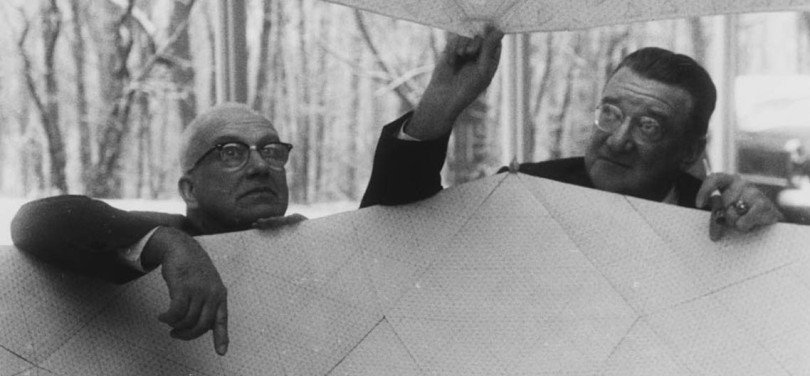
Reference Biography: Walter O’Malley
Putting Their Domes Together
On May 26, 1955, O’Malley wrote a letter to noted architect R. Buckminster Fuller stating: “For some time we have been considering a new stadium for our Brooklyn Dodgers...My experience in operating a number of typical but antiquated stadia has convinced me that we lose a great deal of money each year because of inclement weather and for some time I have been talking about building a new stadium that, among other things, would have a dome over it of a translucent material...Baseball companies, unfortunately, do not have the resources of the large industrial companies. Price would become an extremely important issue...I believe this would open up a new horizon in baseball...I am not interested in just building another baseball park.”
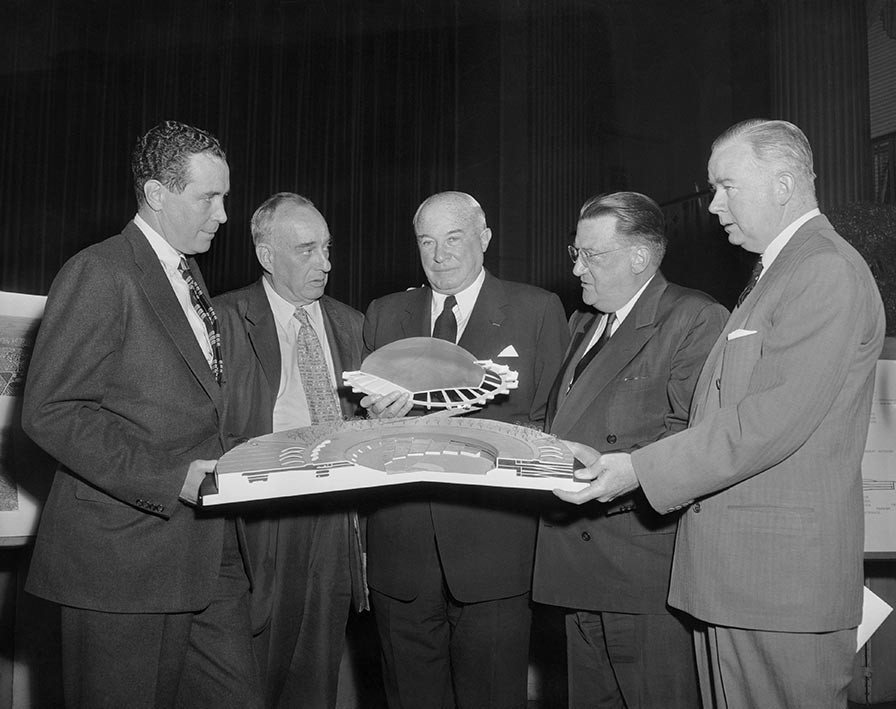
Walter O’Malley inspects a model of a proposed new ballpark with city officials and business leaders on Feb. 28, 1956. Pictured (from left) are Thomas Goodfellow, President of the Long Island Railroad; Robert Moses, Parks Commissioner for the City of New York; Bernard Gimbel, President, New York City Convention Bureau; O’Malley; and John McGrath, attorney for the committee studying the site for a new stadium in Brooklyn.
© Bettman/Corbis
This joint effort between Fuller and O’Malley led to the presentation of a domed stadium model. The domed stadium would have been the state-of-the-art baseball home that the Dodger President had always wanted for Brooklyn. The idea was at least 10 years ahead of its time, as the Houston Astrodome was not opened until 1965. Under Fuller’s tutelage, Princeton University School of Architecture graduate students worked on an impressive clear-span, translucent domed stadium design in November 1955.
Graduate student T. William Kleinsasser, Jr. heard the tail end of one of Fuller’s lengthy “guest” lectures. Later, he was prodded by his French class professor to incorporate Fuller’s ideas to help the situation involving the Dodgers and their search for a new stadium by designing a domed model. On November 23, 1955, O’Malley wrote to Long Island Railroad General Manager Thomas Goodfellow stating, “Today’s newspapers had a little story about a visit I made to Princeton over the week end on a matter connected with our proposed new Dodger Stadium. Mr. T. William Kleinsasser Jr., a graduate architectural student at Princeton is making this project a design problem for his Master’s thesis. I was greatly impressed by the model that the students made and which I saw at Princeton. I am particularly pleased with the way Mr. Kleinsasser is approaching the problem. There is nothing official in the Princeton study or in Mr. Kleinsasser’s work on his thesis insofar as the Dodgers are concerned but it is nevertheless of great interest and might ultimately prove of substantial practical value.
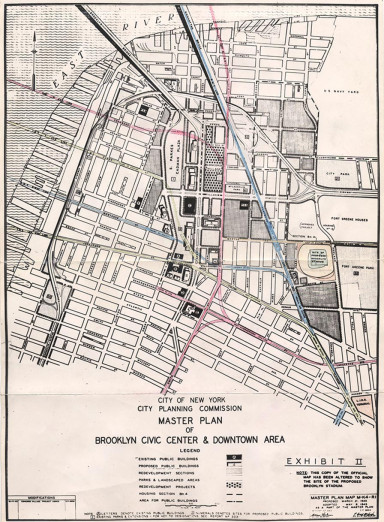
The downtown landscape of the Brooklyn Civic Center includes a new ballpark to replace an aging Ebbets Field, which was built in 1913.
“The Atlantic and Flatbush Avenue site that is the subject of the study is one of the most important subway and railroad intersections in the city and there are detailed maps that I am sure could be made available to Mr. Kleinsasser.” O’Malley letter to Thomas M. Goodfellow, General Mgr., Long Island Railroad, November 23, 1955
Moses, however, strongly condemned this proposal stating in his suggested agenda for the Brooklyn Sports Center Authority on July 25, 1956, “Obviously, the Princeton bubble is simply the idea of an ambitious graduate reporting to a rather wild professor of architecture.” Fuller himself unveiled his concept of a geodesic domed ballpark, which could easily accommodate other year-round events, such as O’Malley envisioned, producing an additional $200,000 in revenue due to the all-weather nature of the structure.
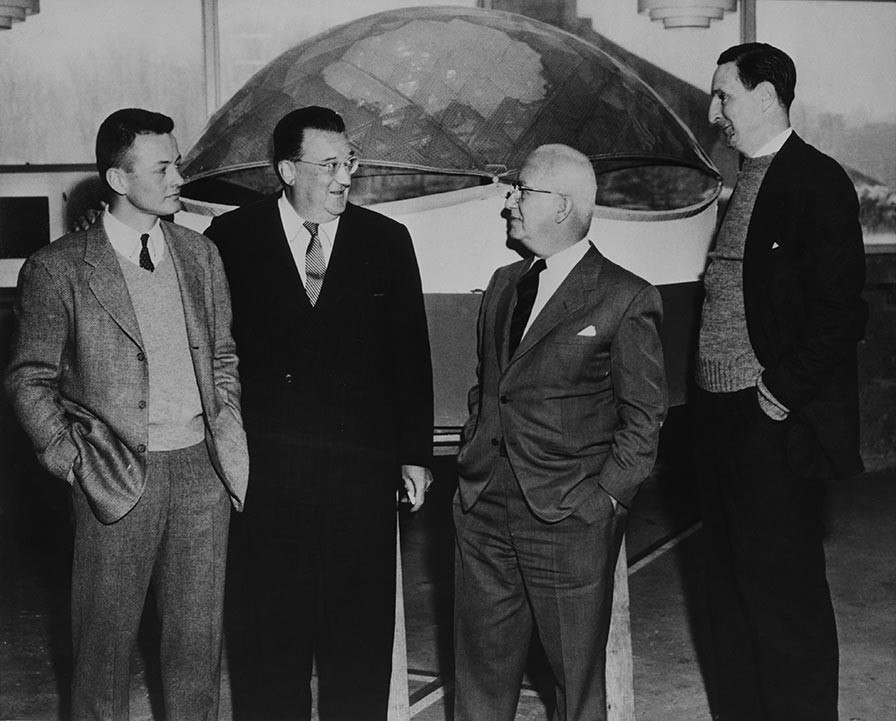
Walter O’Malley visits Princeton University’s School of Architecture where he meets with inventor R. Buckminster Fuller (second from right) regarding the design of a domed stadium for the Dodgers in Brooklyn. Fuller’s graduate architecture students worked on the project at the request of O’Malley. The large scale model all-weather dome structure with a translucent roof was one possible design, while T. William Kleinsasser, Jr. (left) also tried to resolve the design problem as part of his master’s thesis with a different domed model. Robert W. McLaughlin, Jr., director of the school, reviews the work on Nov. 22, 1955.
© Bettman/Corbis
The domed stadium was to be supported by a lightweight truss structure and would be 750 feet in diameter. No seat would have been obstructed, as no posts were to be erected in the first-of-its-kind domed ballpark, which was to sit 300 feet above the pitcher’s mound, or high enough to cover a 30-story building. According to the July, 1956 issue of Mechanix Illustrated, “Kleinsasser’s design is more detailed than Fuller’s and includes such novelties as a small sightseeing tramway over the top of the dome.” The article continued, “The dome design makes feasible the demand for a ball park big enough to hold the enormous Dodger following. It would also be an all-weather, year-round sports palace capable of pulling in big money as a showplace for every kind of sporting event and exposition...The Dodger Dome would certainly become an object of pride in Brooklyn. It might even rival the borough’s ball team in public esteem. In any case, no club could be more deserving of such a fabulous park than the Fabulous Flock.”
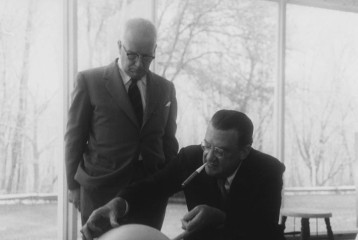
Walter O’Malley and architect R. Buckminster Fuller view a model of a proposed domed ballpark.
Photo by Wil Blanche. Copyright © 1955. All Rights Reserved.
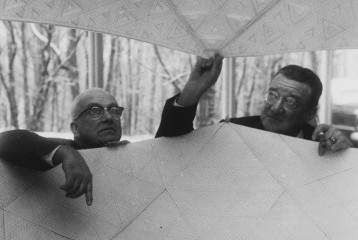
R. Buckminster Fuller’s idea of a geodesic dome intrigued Walter O’Malley, who envisioned year-round use of the New York facility.
Photo by Wil Blanche. Copyright © 1955. All Rights Reserved.
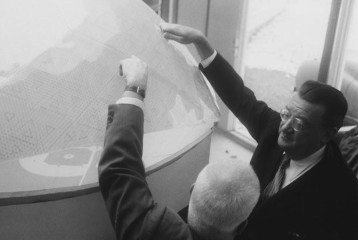
Inspired by a geodesic domed stadium model, Walter O’Malley asked R. Buckminster Fuller about the strength of one of his plastic structures at Huntington Station in Long Island, NY.
After reviewing the Princeton students’ display on November 22, 1955, O’Malley was “thrilled with the work” New York Herald-Tribune, November 23, 1955 and more than convinced that Fuller could achieve the impressive domed stadium that the Dodger President was looking for. However, newspaper accounts reporting that O’Malley immediately retained the inventor to begin engineering calculations on the 52,000-seat stadium at Fuller’s Synergetics, Inc. laboratories in Raleigh, NC and Cambridge, MA were incorrect. New York Post, November 23, 1955 O’Malley’s correspondence shows his concern about this error, because he had a fine relationship with engineer Praeger of Praeger and Kavanagh who was at the ready to design the stadium. Fuller wrote O’Malley a letter on December 1, 1955, “you had authorized me to say that ‘my friend, Walter O’Malley, has authorized me to undertake an informal study of the adaptation of the Geodesic dome to a theoretical new Dodgers stadium,’ and several weeks later that I had been authorized to carry out that informal study during my Princeton seminar. After this careful phrasing, I have always gone on to say that this is Walter O’Malley’s show and that any misstatement of these facts could be offensive to him or could even damage his potential realization of such a facility, should it develop into an actively desirable potential.”
For those who suggest that “you can’t throw stones at glass houses,” O’Malley firmly believed that you could throw baseballs (and maybe footballs) in them. Actually, O’Malley and several friends took on that challenge, requesting permission to throw rocks at one of Fuller’s plastic structures, a 1/2 geodesic sphere of 55-foot clearspan diameter dome at Huntington Station, Long Island, NY in August 1955. According to a Dodger press release on October 2 of that year, “They were granted permission and despite the explosive sound of the impact no damage to the dome resulted.”
Interestingly, O’Malley likened the translucent domed structure to that of a greenhouse, where he and his wife, Kay, spent many pleasant hours in their backyard in Amityville. Both he and Kay cultivated exotic and award-winning orchids in a family greenhouse. It was a source of enjoyment for them and O’Malley found it a soothing hobby, relieving him from the hustle and bustle of day-to-day work responsibilities. “A dome constructed of a translucent material would eliminate shadows and give a pleasant interior effect of the sort one finds in a greenhouse,” O’Malley said in a Dodger press release (November 23, 1955) regarding his proposed domed stadium. “Such a structure would make it possible to have controlled temperature inside.”
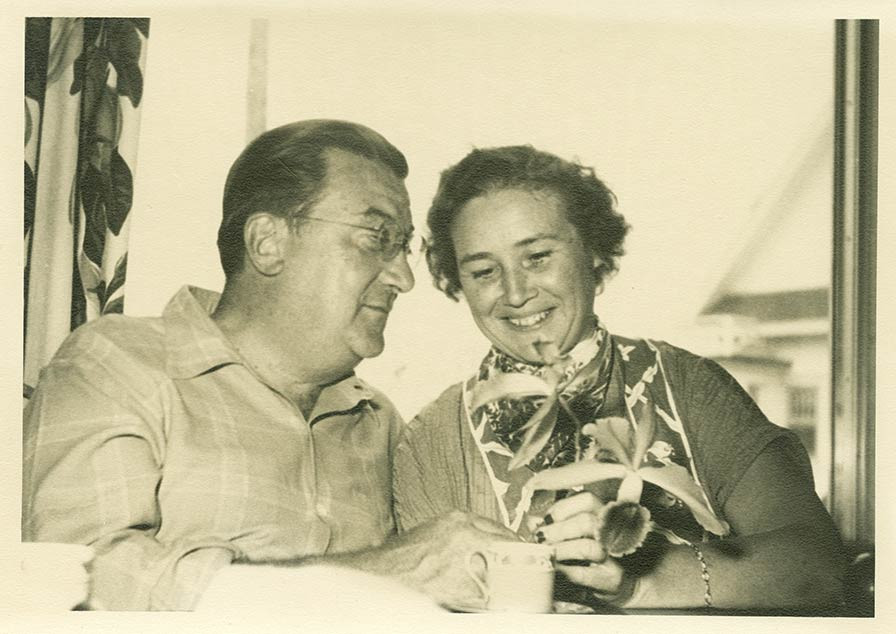
Walter and Kay O’Malley at the family greenhouse in Amityville, New York, where the Dodger President enjoyed spending time cultivating exotic orchids.
He also thoroughly enjoyed planting and watching everything grow...not only in the greenhouse, but in business, as well. The seeds sown, if properly cultivated and watered, would one day blossom and produce.

